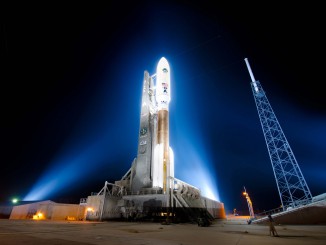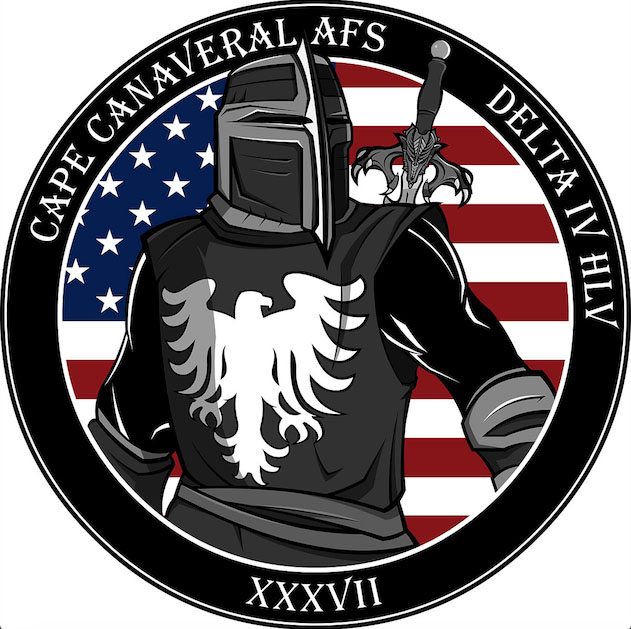
CAPE CANAVERAL — One of the largest satellites in the world will launch aboard America’s biggest operational booster Thursday, riding that power to a listening post 22,300 miles above the planet for its clandestine eavesdropping mission, all indications suggest.
A United Launch Alliance Delta 4-Heavy rocket will fly from Cape Canaveral’s Complex 37 at 1:59 p.m. EDT (1759 GMT). Although the duration of the day’s usable launch window has not been revealed, officials previously said liftoff would occur by 6:30 p.m. EDT (2230 GMT).
Weather forecasters say there is a risk of showers and thunderstorms, dropping the odds of acceptable launch conditions to 40 percent due to anvil clouds, cumulus clouds and lightning.
If the launch is scrubbed on Thursday, the next try would come on Saturday afternoon. Weather improves to 80 percent favorable then.
This rocket was chosen to conduct the high-priority national security launch because it can deliver the payload directly into geosynchronous orbit, requiring three burns by the upper stage and operation after a long coast to reach the destination about seven hours into flight.
The Delta 4-Heavy is capable of delivering 14,900 pounds of payload into a circular geosynchronous orbit, the most of any rocket flying today. The vehicle’s maximum operation time is eight hours.
Most satellites headed to 22,300 miles up use a circuitous route to get there after being deployed from their launch vehicles in highly elliptical transfer orbits. The spacecraft must use onboard propulsion to systematically circularize the orbit.
But the payload flying on this Delta 4-Heavy will rely upon the rocket to do all the boosting, initially reaching a low-altitude parking orbit, then stepping to the egg-shaped transfer orbit and finally firing a third time several hours later to circularize the altitude without the satellite having to do it independently.
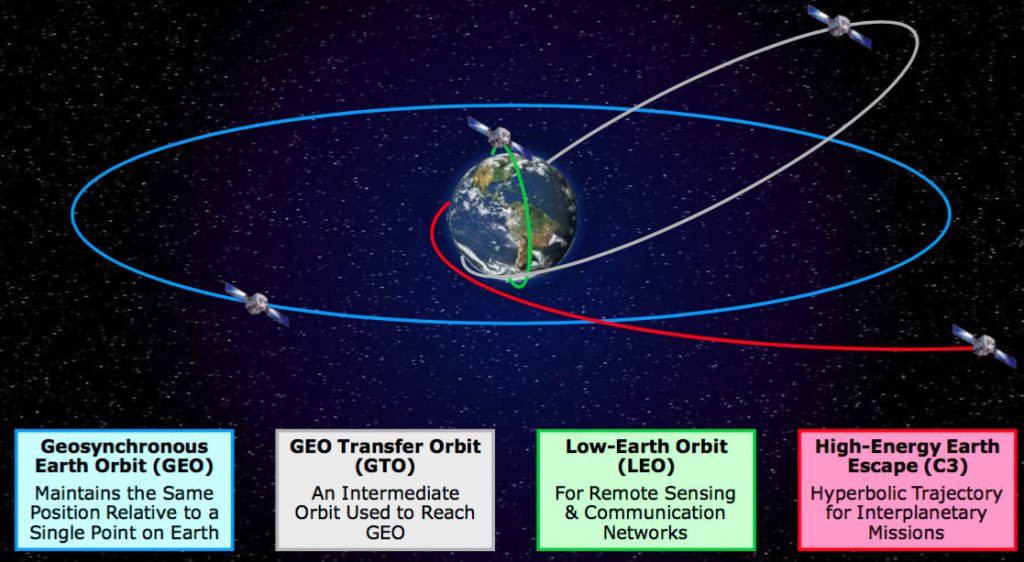
Geosynchronous orbit is used by spacecraft — such as television broadcast birds, weather observatories and reconnaissance satellites — because that is where they match Earth’s rotation and stay locked over one area of the globe.
The spacecraft launching Thursday comes from the National Reconnaissance Office, the secretive government agency responsible for the country’s spy satellites and overhead surveillance for the intelligence community.
The NRO was created in 1961 and its existence was admitted publicly for the first time in 1992. The first NRO launch to be acknowledged in advance occurred in 1996.
This launch is known as NROL-37.
The NRO has flown various types of communications-interceptors since the dawn of the space age, and analysts say it is virtually certain this Delta 4-Heavy is hauling another.
“I believe the payload is the seventh in the series of what we call Mentor spacecraft, a.k.a. Advanced Orion, which gather signals intelligence from inclined geosynchronous orbits. They are among the largest satellites ever deployed,” said Ted Molczan, a respected sky-watcher who keeps tabs on orbiting spacecraft.
A former NRO director called this type of satellite the largest in the world, and for good reason. It will unfurl a gigantic antenna to overhear enemy communications and aid U.S. intelligence.
“The satellite likely consists of sensitive radio receivers and an antenna generally believed to span up to 100 meters (328 feet) to gather electronic intelligence for the National Security Agency,” Molczan said.
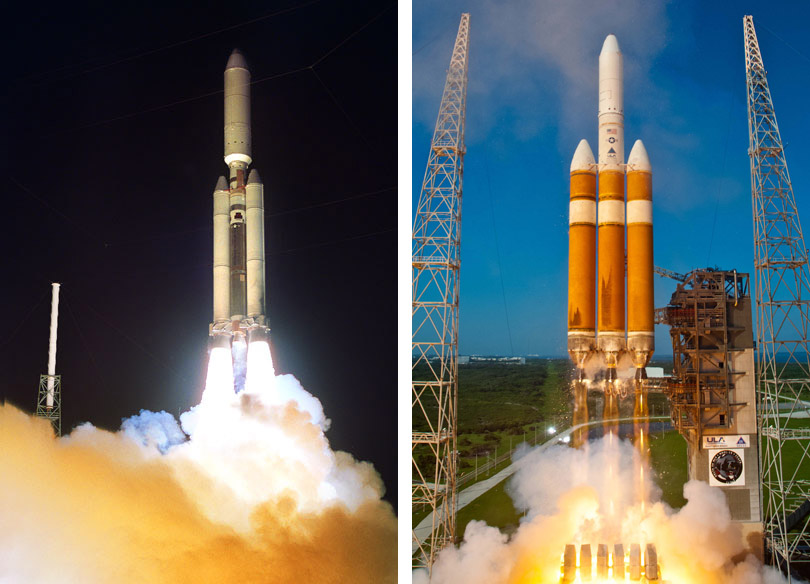
Observers think the mesh antenna’s diameter is the size of a football field, comparable to the International Space Station’s width. That explains why satellite-tracking hobbyists say these Mentor craft are “by far the brightest” in geosynchronous orbit and seen from the ground, outshining conventional craft.
Although NRO satellites are secretive by nature, the spacecraft are visible by just looking up. Molczan is a member of a hobbyist group that routinely finds and watches the craft while monitoring the skies with precision.
Experts believe Northrop Grumman builds these spacecraft and Harris Corp. makes the unfurlable antenna systems.
It is not known in advance where in the geosynchronous belt the new satellite will be positioned or what part of the globe it will cover.
“The upcoming launch may replace one of the older spacecraft in the series, or augment the fleet by occupying a new location in geosynchronous orbit,” Molczan said.
Previous Mentor satellites were launched by Titan 4 rockets from Cape Canaveral in 1995, 1998 and 2003, plus Delta 4-Heavy flights in 2009, 2010 and 2012.
The lineage can be traced to the two Magnum satellites trucked to orbit aboard the space shuttle Discovery during the STS-51C mission in 1985 and STS-33 in 1989.
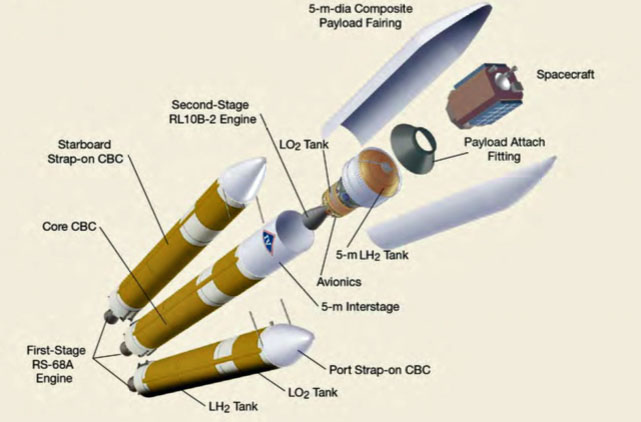
United Launch Alliance’s Delta 4-Heavy is America’s biggest unmanned rocket currently in service, capable of lofting the largest and heftiest cargos. Its most recent mission launched NASA’s Orion capsule on the Exploration Flight Test in 2014.
The Heavy is created by taking three Common Booster Cores and strapping them together to form a triple-barrel rocket, and then adding an upper stage.
The vehicle stands 235 feet tall, is 53 feet wide, weighs 1.6 million pounds fully fueled and will unleash 2.1 million pounds of thrust at launch.
The rocket comes off the pad powered by three Aerojet Rocketdyne RS-68A engines, one apiece on the Common Booster Cores. The throttleable engine burns liquid hydrogen and liquid oxygen to produce 702,000 pounds of thrust each.
The Port and Starboard liquid rocket boosters stand more than 150 feet tall and the Center Core is over 175 feet with interstage permanently attached. Each booster measures 16.7 feet in diameter and is covered in orange insulating foam.
The cryogenic upper stage also burns liquid hydrogen and liquid oxygen to power its single Aerojet Rocketdyne RL10B-2 engine for 24,750 pounds of thrust. It features a cone-shaped carbon-carbon extendible nozzle that is 7 feet in diameter.
The stage carries 60,000 pounds of propellant and can operate for nearly 19 minutes in all. It features a larger diameter liquid hydrogen tank and a lengthened liquid oxygen tank from the stage used by the lower-power Delta 4-Medium rockets.
This will be the 374th Delta rocket launch since 1960, the 32nd Delta 4 since debuting in 2002 and the 9th Heavy.
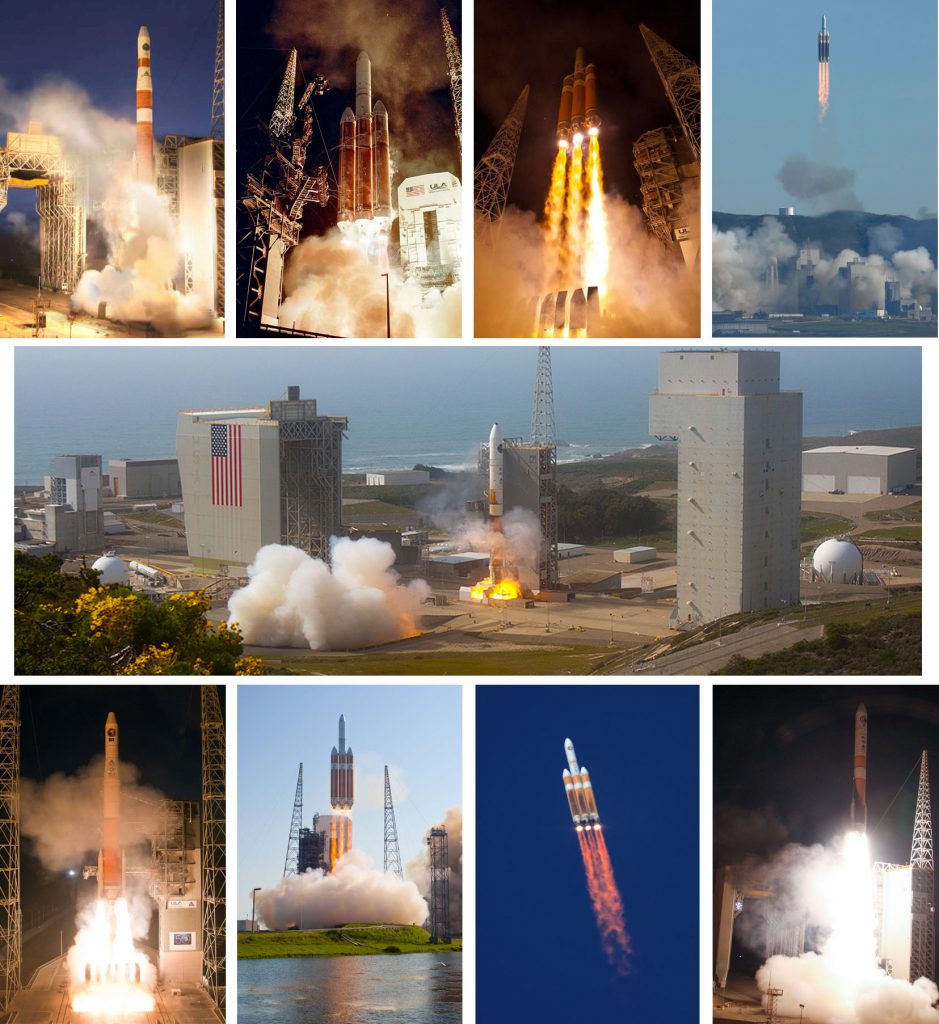
The Delta 4 vehicle has flown 9 times for the National Reconnaissance Office, five of which were Heavy launches.
Delta 317: NROL-22 on Medium+ (June 27, 2006) Trumpet F/O eavesdropping
Delta 337: NROL-26 on Heavy (Jan. 17, 2009) Mentor 4 eavesdropping
Delta 351: NROL-32 on Heavy (Nov. 21, 2010) Mentor 5 eavesdropping
Delta 352: NROL-49 on Heavy (Jan. 20, 2011) KH-11 exquisite imaging
Delta 353: NROL-27 on Medium+ (March 11, 2011) Quasar data relay
Delta 359: NROL-25 on Medium+ (April 3, 2012) Topaz 2 radar imaging
Delta 360: NROL-15 on Heavy (June 29, 2012) Mentor 6 eavesdropping
Delta 364: NROL-65 on Heavy (Aug. 28, 2013) KH-11 exquisite imaging
Delta 373: NROL-45 on Medium+ (Feb. 10, 2016) Topaz 4 radar imaging
United Launch Alliance intends to retire the single-stick Medium configurations of the Delta 4 by early 2019. But the Heavy vehicle will continue to serve the national security niche market into the 2020s.
Technicians at the ULA factory in Decatur, Alabama, will build and stockpile the cores for several Heavy vehicles before the Medium’s retirement. Making the rockets now, then allowing the entire assembly line to shut down and simply storing the Heavy vehicles is the economic way to go, officials said.
The government is deciding exactly how many Heavy rockets it will want ULA to stockpile. There’s at least 6 missions — five for the NRO and one science probe for NASA — baselined to fly on Delta 4-Heavy rockets through 2022.
2018
Delta 4-Heavy with NASA’s Solar Probe Plus (Cape Canaveral) *
Delta 4-Heavy with NROL-71 (Vandenberg) *
2019
Delta 4-Heavy with NROL-44 (Cape Canaveral)
2020
Delta 4-Heavy with NROL-82 (Vandenberg)
2021
Delta 4-Heavy with NROL-68 (Cape Canaveral)
2022
Delta 4-Heavy with NROL-70 (Cape Canaveral)
* NASA and the Air Force have formally purchased their 2018 launches aboard Delta 4-Heavy rockets. Launch services for the other NRO flights have not yet been contracted.
ULA’s future Vulcan-ACES vehicle will replace the capabilities of the Delta 4-Heavy that the company offers to the government.
See earlier Delta 374 coverage.
Our Delta archive.


